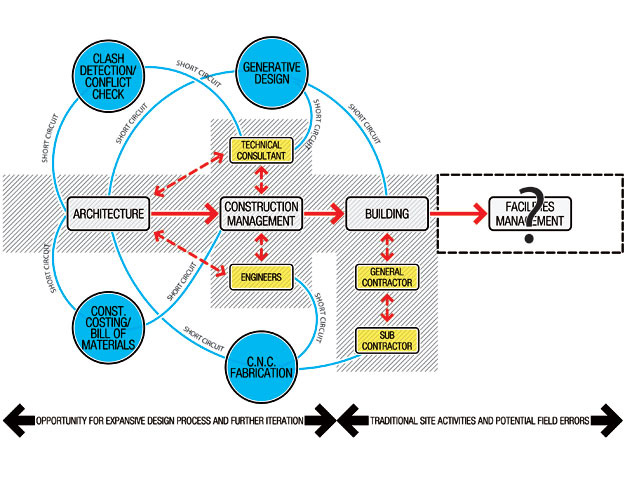Building Information Modeling as a Design Process
BIM and Design
Among the professionals who have studied the full potential and promise that BIM holds for architects, Richard J. Garber, AIA, director of the School of Architecture at New Jersey Institute of Technology (NJIT), is noteworthy. Beyond his impressive academic career focused on building sciences and green architecture, he is also a practicing architect and principal in the New York City-based firm of GRO Architects, PLLC, allowing him to experience both the real-world issues of running a firm in addition to researching the trends and experiences of other firms around the globe. He has recently authored a book, published in England, titled BIM Design – Realising the Creative Potential of Building Information Modelling.1 In this work, he confronts the role of architects and others in the design and construction process. He points out that the typical 20th-century architect became increasingly separated from the construction process as new professions of construction managers and owners' representatives began to take on leadership roles previously enjoyed by architects. Accordingly, architectural offices became places where drafting tables were the primary workstation, and a hierarchy of designers, managers, and draftsmen produced 2D representations of buildings on linen, paper, or Mylar media. Some design professionals had limited exposure to the on-site construction processes or the people involved in the fabrication of products, materials, or construction of the building.
Garber points out that this separated role of the architect is in sharp contrast to the historical role of being the “Master Builder” who was responsible not only for the design but for the execution of the construction through to completion, as well. In some locations, the emergence of “design-build” firms has sought to reclaim this Master Builder role although there is certainly a mix of results on that front. In some cases, architects have been the leaders of the design-build process while in other cases they act essentially as subcontractors to a construction firm. Furthermore, in some parts of the United States, licensing laws and design-build legislation have severely limited an architect's role in design-build projects.
Nonetheless, there remain many architects who care deeply about construction as the actualization of their design work. They understand that successful designs rely on a real knowledge of materials, products, fabrication processes, and construction assembly techniques. They also acknowledge that new versions of all of these things are constantly being developed, requiring the input of specialists focused on particular aspects of a building.

Image courtesy of Richard Garber, AIA, and GRO Architects, PLLC
In a 21st-century practice, the use of BIM allows for a more coordinated and integrated team that embraces and facilitates a truly iterative design process.
What does all of this have to do with the design process? Garber asserts that computerized building information modeling allows the architect to use new tools to re-connect design directly with the construction process and regain the lead role in the overall process. It is significant to note that he uses the word “modeling” rather than the word “model.” Modeling is a verb indicating an ongoing activity that starts with the very beginning of the design process and carries all the way through construction and even facility management. Model is a noun and refers to one of multiple outputs of the modeling process. This is not unlike thinking about the difference between using the word “drawing” as a noun or a verb. Drawing as an action is what architects and draftspersons are known to do as an ongoing process to explore, alter, and ultimately produce a final design. A drawing, used as a noun, is the output of the process of drawing. Hence, the first thing an architect needs to understand about realizing the full potential of building information modeling is that it should be regarded as an active process and not a static output. Further, as a fully customizable process, it is entirely adaptable to meet the personal design process of virtually any firm or individual. There is no one BIM process any more than there is only one drawing process.









